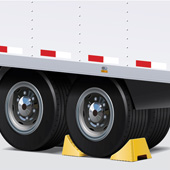Air Brake Compliance
Drivers of vehicles with air brakes must understand and comply with the Ontario Highway Traffic Act and regulations, as well as general safety issues. These are outlined in this chapter. In addition, this chapter explains what to do when you find a defect in the air brake system.
Safety standards for commercial vehicles
The Ontario Highway Traffic Act and regulations provide specific requirements for the safe operation of commercial motor vehicles. When vehicles fail to comply with these requirements, the driver, operator and owner of the vehicle must ensure that the vehicle is not driven on any road or highway. Operating a vehicle that does not comply with the Ontario Highway Traffic Act and regulations is an offence that carries penalties. These may range from a fine to vehicle detainment or impoundment.
Important: Operating a vehicle with defects or failing to conduct the required inspections can result in charges against the driver and/or operator, as well as detainment or impoundment of the vehicle.
Safety concerns while inspecting air brake systems
When conducting an inspection of the air brake system, be sure to take the following precautions to avoid potential hazards:
- Park on a level surface to keep the vehicle from rolling. Inspection of the air brake system requires certain steps to be completed with the parking brakes released. A level surface will reduce the possibility of unexpected vehicle movement.
- Park away from traffic and other hazards to provide a safe work area around the vehicle to conduct the inspection.
- Turn off the engine. Moving parts within the engine compartment pose safety hazards, so inspections should always be performed with the engine stopped.
- Secure the vehicle with wheel chocks or blocks to prevent vehicle movement during the inspection. (See Diagram 8-1.) Wheel chocks or blocks must be used whenever a test or inspection procedure requires the driver to leave the driver’s seat with the parking brakes released.
- Avoid getting in the direct path or immediate area of compressed air exhausting from air brake system components.
Remember: Inspections of vehicles with air brakes must be completed at regular intervals to ensure they comply with the Ontario Highway Traffic Act and regulations. Drivers are required by law to report any defects of the air brake system to the vehicle operator.

Diagram 8-1: Correct position of wheel chocks
Key points to remember
- Vehicles with air brakes must comply with the Ontario Highway Traffic Act and regulations. If a vehicle does not comply, both the driver and the operator may be charged.
- When conducting an inspection, make sure the vehicle is parked on a level surface, in a secure manner and in a safe location.
- Wheel chocks or blocks should be used to prevent vehicle movement during an inspection.
- During an inspection, drivers must be cautious of moving vehicle parts and compressed air exhausting from the vehicle.
- The Ontario Highway Traffic Act and regulations prohibit the driving or operation of a vehicle with a defective air brake system on any road or highway.